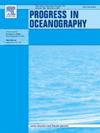热和非热过程对北印度洋海洋表面pCO2变率和缓冲能力的影响
IF 3.6
3区 地球科学
Q1 OCEANOGRAPHY
引用次数: 0
摘要
海洋已经吸收了近30%的人为二氧化碳,这些二氧化碳改变了海洋的碳化学成分。海洋的过程是高度复杂的,这就需要将其物理、化学和生物状态结合起来的方法。本文采用大气-海洋-生物地球化学耦合模型,结合大气CO2的时空变化,模拟了2013-2020年北印度洋(NIO)的碳动态。我们评估了溶解无机碳(DIC)、总碱度(ALK)、海洋表面二氧化碳分压(pCO2)和缓冲能力的季节变化。为了评估控制该地区碳动态的机制,我们将海洋表面二氧化碳分压分为温度驱动(热)和生物物理过程诱导(非热)的二氧化碳分压。研究发现,夏季(6、7、8、9月)以热驱动pCO2为主;冬季(12月、1月和2月)非热成分;DJF)在阿拉伯海北部(AS)。冬季北部AS以深层混合层和对流引起的垂直混合为特征。亚表层的DIC被抬升到表层,导致冬季海面pCO2偏高。在阿曼海岸外,非热过程控制着夏季海面的二氧化碳分压。北部湾夏季以pCO2的热组分为主,冬季与北部一样以非热组分为主,但由于河流通量较大,其量级较小。预算分析表明,扩散、CO2通量和生物过程在控制NIO DIC变化方面具有重要作用。上升流区缓冲能力较低,表明pCO2变化对DIC变化更为敏感,这主要是由于上升流区表层水体富含DIC。因此,它会导致吸收二氧化碳的能力降低。这证明有必要解决最近因大气二氧化碳水平增加而引起的碳动态变化。本文章由计算机程序翻译,如有差异,请以英文原文为准。
Effect of thermal and non-thermal processes on the variability of ocean surface pCO2 and buffering capacity in the north Indian Ocean
The oceans have absorbed nearly 30% of the anthropogenic CO2 that alters the ocean carbon chemistry. The oceanic processes are highly complex, which mandate approaches that couple its physical, chemical and biological states. Here, we use a coupled atmosphere–ocean-biogeochemistry model, incorporating spatially and temporally varying atmospheric CO2 to simulate the north Indian Ocean (NIO) carbon dynamics for the period 2013–2020. We assess the seasonal variability of Dissolved Inorganic Carbon (DIC), total Alkalinity (ALK), ocean surface pCO2 and buffering capacity. To assess the mechanisms that control carbon dynamics in the region, we segregate the ocean surface pCO2 into temperature-driven (thermal) and bio-physical processes induced (non-thermal) pCO2. We find that the thermally driven pCO2 is dominant in summer (June, July, August and September; JJAS), but the non-thermal component in winter (December, January and February; DJF) in the northern Arabian Sea (AS). The northern AS is characterised by a deep mixed layer and convection-induced vertical mixing during winter. DIC from the subsurface layer is uplifted to the surface, which results in high ocean surface pCO2 in winter. Off the Oman coast, the non-thermal processes control the surface pCO2 in summer. In the northern bay, the thermal component of pCO2 is dominant in summer and non-thermal component in winter as in northern AS, but their magnitudes are lower due to large riverine flux. The budget analysis reveals strong influence of diffusion, CO2 flux and biological processes in controlling DIC variability in NIO. Low buffering capacity in upwelling regions indicates that pCO2 changes are more sensitive to changes in DIC, primarily due to the upwelled DIC-rich surface waters. Therefore, it results in a reduced ability to absorb CO2. This warrants the need to address recent changes in carbon dynamics in response to the increased levels of atmospheric CO2.
求助全文
通过发布文献求助,成功后即可免费获取论文全文。
去求助
来源期刊

Progress in Oceanography
地学-海洋学
CiteScore
7.20
自引率
4.90%
发文量
138
审稿时长
3 months
期刊介绍:
Progress in Oceanography publishes the longer, more comprehensive papers that most oceanographers feel are necessary, on occasion, to do justice to their work. Contributions are generally either a review of an aspect of oceanography or a treatise on an expanding oceanographic subject. The articles cover the entire spectrum of disciplines within the science of oceanography. Occasionally volumes are devoted to collections of papers and conference proceedings of exceptional interest. Essential reading for all oceanographers.
 求助内容:
求助内容: 应助结果提醒方式:
应助结果提醒方式:


